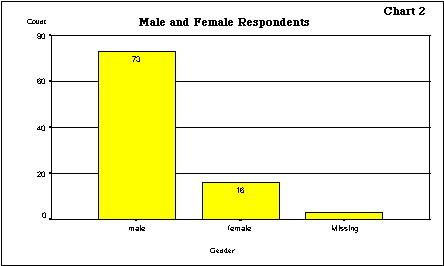Dickinson Summer Seminars on Teaching Physics
Using Interactive Teaching Methods on Computers
Return to Table
of Contents
Previous Page
II. Overview of the ITMC Survey Population
A total of 235 college instructors and high school teachers
attended the summer seminar on teaching physics using Interactive
Teaching Methods and Computers (ITMC) at Dickinson College
between 1990 and 1996. College instructors have attended since
the beginning, while high school teachers began attending
in 1996. Of those in this targeted population, 35 could not
be reached, or did not find it appropriate to respond for
other reasons (e.g., several retired unexpectedly shortly
after attending, others were graduate students who have continued
their studies and have not yet entered the teaching field
full-time). A total of 92 responses were received from the
remaining target population of 200, for a response rate of
45%. A breakdown of respondents by year of attendance is provided
in Chart 1, below.

Of the 92 respondents, 73 (79%) were male and 16 (17%) were
female (see Chart 2). Overall, the group was quite experienced,
having taught physics for an average of 19 years. The distribution
of years of experience appeared to be bimodal. Over one-third
of those responding fell in the "low experience"
range of 3 to 12 years. This peak was followed by a drop-off
in responses from those in their "mid-experience"
years of 13 to 22 years (n=20). The second mode consisted
of respondents who had a good deal of experience. Close to
one-third of those responding had 23-32 years of experience.
This peak was followed by a steep drop-off, as less than 10%
of the respondent population had over 32 years of experience
teaching (see Chart 3).


The majority of those who responded work in small departments:
Nearly two-thirds (64%) taught in departments with faculty
ranging from 1 to 5 (see Chart 4). Similarly, respondents
tended to work at relatively small institutions. Fifty-nine
respondents (57%) reported working in institutions of less
than 3,000 students. The small institutional size is partly
attributable to the inclusion of high school teachers in the
sample (see Chart 5).
Fourteen respondents taught in high schools, while the plurality
taught in colleges offering a bachelor’s as the highest
degree (42%). A slight majority (51) taught in public institutions
(55%; see Chart 6).
Of those teaching high school, nearly everyone, 15 of
16 respondents, reported using ITMC in "Regular Physics"
courses, and half (8) reported using ITMC in teaching advanced
physics. At the college level, a majority of respondents reported
using ITMC methods in "Calculus-based" (57%) and
"Algebra-Based" (51%) physics courses. At the same
time, it appears that a wide variety of courses are being
taught using ITMC at both the high school and the college
levels (see Charts 7 and
8).
Those who teach physics using lectures (63) reported
that the average class size was 56 students, the average class
lasted 52 minutes, and the average course had 48 class sessions.
The number of classes is inflated somewhat by including the
high school respondents in the survey.
Those who teach labs (61) reported that the average lab
had 22 students and lasted about 2 hours and 15 minutes. About
11 lab sessions per course were conducted, on average.
Those who reported teaching physics using the "workshop"
approach (31) reported an average class size of 27 students.
On average, classes last about 1 hour and 20 minutes, and
courses consisted of about 35 class sessions. Once again,
the number of class sessions per course is inflated somewhat
by including the high school respondents in the survey.
In addition to lectures, labs, and workshop sessions,
a catchall "alternative sessions" category was provided
to capture activity that took place outside regularly scheduled
lectures, labs, and workshop sessions. A number of respondents
reported regularly using several types of alternative sessions,
including group problem solving sessions (10), interactive
tutorials (4), and recitations (7; see Chart 9). These sessions
had an average of 18 students, lasted about an hour, and were
conducted about 13 times during the teaching of the
course.
Return to Table
of Contents
Next Page
|

